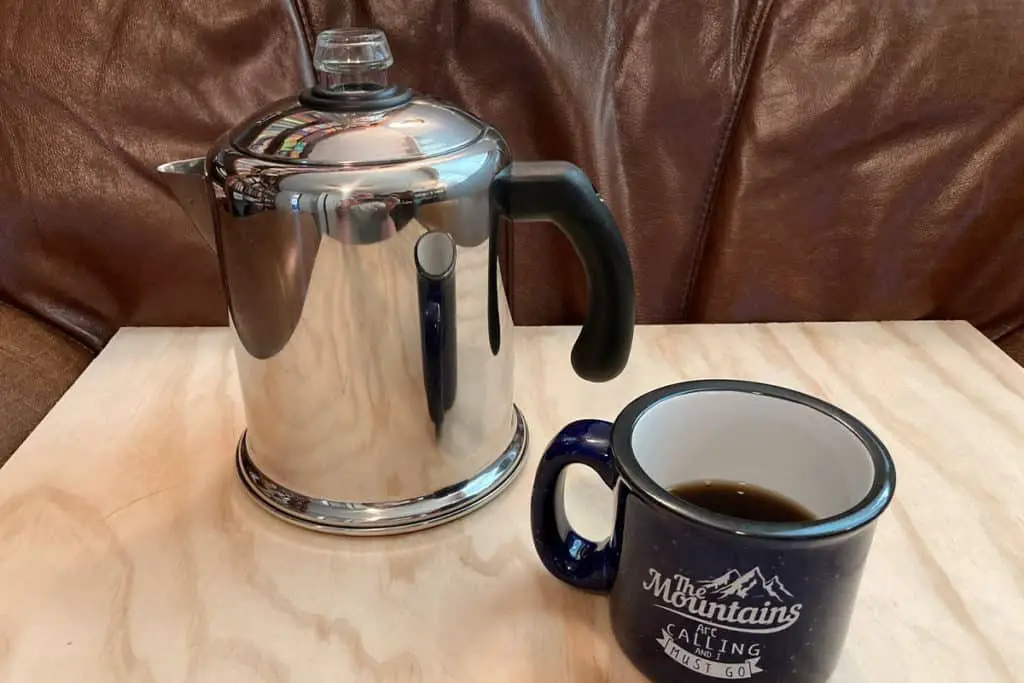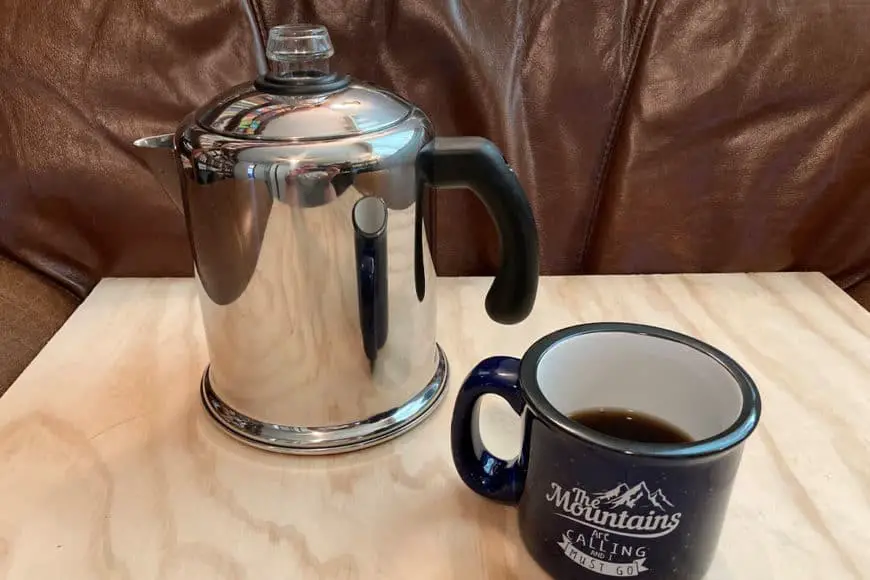
Are you tired of weak, flavorless coffee from your electric coffee maker? If so, it might be time to try using a stovetop percolator. A stovetop percolator is a classic coffee brewing method that has been used for generations, and it’s known for producing rich, full-bodied coffee with a bold flavor.
Whether you’re a coffee connoisseur or just starting to experiment with different brewing methods, a stovetop percolator is a must-try.
In this blog post, we’ll show you how to use a stovetop percolator and provide tips for making the perfect cup of coffee. So, grab a percolator and a bag of your favorite coffee beans, and let’s get started!
The Stovetop Percolator Resurrection
In this era of craft this and bespoke that, a new generation of java junkies are rediscovering the pot that time forgot. They’re channeling grandma and going old school, but with a twist. They’re applying the high standards of the specialty coffee craze to the old tin soldier.
The biggest advantage of choosing perked coffee, aside from the taste, is the aroma. No other method will fill your house with such a rich, decadent aroma. While it might not be for you if you’re in a rush, it doesn’t take much longer than other popular methods.
If there’s one thing that elevated coffee culture has proved, it’s that there’s more than one way to brew a great cup of joe. In fact, coffee snobbery only started to gain ground in the wake of the automatic drip coffeemaker’s deficiencies.
If you look hard enough, you’ll find that there are at least twenty ways of getting that juice out of the bean.
Perked coffee can definitely be craft coffee if you use a stovetop model. Don’t confuse it with a moka pot or the electric model. Moka pots use fine ground beans and produce a thick, distinctive cup more akin to espresso. Electric percolators take too much time and temperature control away from the brewer.
The most difficult part of using a Stovetop percolator is the heat adjustments. However after a couple of attempts brewing you will easy figure it out and understand how simple this brewing method is.
What you need
Brewing coffee in a Stovetop percolator is a straight-forward affair. But there are a few things you’ll want to gather before you get started
- Percolator
- Pot Holder
- Water
- Fresh Roasted Coffee
- Burr Coffee Grinder
- Tablespoon
- Favorite Mug
- Timer
How to Brew Coffee Using a Stovetop Percolator
1. Measure Your Water
Start by filling the empty pot with enough water to yield the number of cups you want. Don’t put the gravity tube and basket in yet. Let the water to heat up by itself first.
This controls the amount of time the grounds get steamed before percolation starts. If the water begins to boil before you start the next step, lower the heat so that the temperature falls back below the boiling point.
Percolation happens below the boiling point. You want to keep the temperature below 205 degrees throughout the whole process.
2. Grind Your Fresh Roasted Coffee
While the water is heating up, grind your coffee beans on a coarse setting and place them in the basket. You’ll want to add a tablespoon of grounds for each cup of water you put in the pot. Next, put the basket on the tube, place the assembly into the pot, and snug the lid into place.
3. Adjust the Heat
Now the fun begins. Turn the burner up to medium heat. Remember that your control of the water temperature is the most critical element now. The Specialty Coffee Association of America recommends brewing water to be between 195 and 205 degrees. Deviate from that and you’ll taste it in the cup.
How will you be able to tell how hot the water is? It’s easy. Count how often the coffee burbles up into the knob in the lid. Dial the heat up or down a bit so that it’s happening about once every three seconds. How long you let the coffee perk is up to you, but for a baseline, shoot for eight minutes this time.
Is your coffee is too strong or too weak for your taste? Next time you brew a pot you can adjust the coffee grind, the amount of coffee in the basket, or the amount of time it’s perking. You’ll get different results.
4. Watch the Time
When your timer reaches eight minutes, turn the heat off and let the coffee sit for a couple of minutes. The water will still be dropping through the grounds. Any stray grounds that got out of the basket will settle to the bottom of the pot.
5. Remove the Tube and Basket
Then grab your pot holder and use it to remove the lid from the pot. Be careful when removing the tube and basket assembly. This will prevent grounds from escaping the basket when you go to pour coffee into your cup. It’s best to place it on a paper or cloth towel under it to catch any drips if there’s still a bit of water in the basket.
6. Sit Back, Sip and Enjoy
Now it’s time to pour and enjoy! You’ll thank yourself if you take some notes. Write down how the coffee tasted, what you might change to make it stronger or weaker next time.
Record the grinder settings you used, and how many grounds you put in the basket. Do you want to change the brewing time or temperature? It’s best only to fiddle with one of them at a time, but if you want to live on the wild side, you can make more adjustments.
Tips for Better Stovetop Percolator Coffee
With any brewing method, there are four elements that interact to determine how good or bad your cup of coffee will be.
- Water
- Coffee beans
- Time
- Temperature
The interactions can be simple or intricate. Your coffee beans are fresh. You’ve ground them to perfection. You timed the brew down to the second. But if your water sucks, your coffee will suffer.
If you’ve chosen the wrong sized grind for your brewing method, your coffee will be too weak or strong, sour or bitter. But let’s get on to it and learn how to perfect our perk.
Use Quality Good Water
If your brewing water isn’t good, it doesn’t matter how you brew it, so will your coffee. Don’t use tap water unless your faucet has a water filter on it, or you have a well. Most tap water has chlorine in it. If your water smells like a swimming pool, it won’t make your coffee any good. What do you use instead?
Next time you go to the store, reach instead for a jug of spring water of filtered water. Stay away from distilled water. It has less minerals and is more acidic. Spring water or filter purified water are the only way to go.
Brew with Fresh Roasted Coffee
If your coffee beans are fresh and you’re using a brand that you know and love, the most important aspect is the grind. It’s best to stay away from pre-ground coffee, because oxidation has already made it stale by the time you open it.
You have two choices when it comes to coffee grinders. Blade grinders are the ones most often seen, but they’re inferior to burr grinders. They leave some big chunks, some smaller chunks, and some pulverized to powder.
Conical burr grinders provide a uniform grind. They can grind coffee from a powdery espresso up to a coarse grind. You’ll find them online or at your favorite department store.
How to Find a Quality Stovetop Percolator
New stovetop coffee percolators are easy to find online. If you want to get old school, head to your local flea market. Make sure the tube and basket are inside and that the lid is snug.
Coffee percolators have three parts:
- the pot itself
- a vertical tube
- a perforated basket that sits on top of the tube.
The tube pulls the heated water from the bottom of the pot to the top. Then it percolates down through the grounds in the basket and falls back into the pot. Most models have a glass knob in the center of the lid so you can see the intensity of the perking and how dark the coffee is.
How to Clean your Percolator
Now you’ve got a mess to clean up, but cleaning your percolator is easy. Because of their simple design, you can put all three parts in the dishwasher if you have one.
If not, hand wash it as you would the rest of your pots and pans. The one part that can use an assist is the tube. A long-handled nylon bristle brush works best.
If coffee stains the inside of your perk in spite of regular cleaning, deep clean it with these ordinary household items, like grandma did. First, add half cup of water to the pot along with a couple tablespoons of baking soda.
Give both the pot and the basket a scrub with a soft cloth. Wet your nylon bristle brush and put some baking soda on it, then insert it into the tube a few times.
Once you’ve rinsed everything, fill the pot with equal parts water and white vinegar. Run it through a cycle as if you were making coffee, except don’t add the coffee! When it’s done, dump the water and vinegar solution into the sink and rinse everything out again with cool water.
Many happy cups to you.

